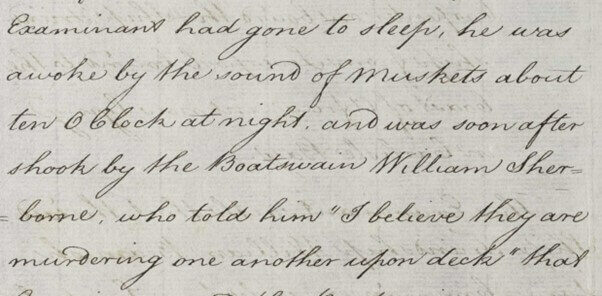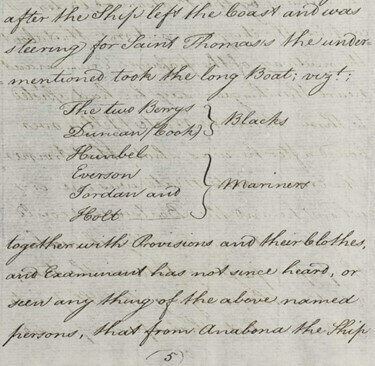Enmity on board the Friendship: A tale of mutiny from Colonial Caribbean
All my life, I have been drawn to stories of the sea. My grandfather’s bookshelf was lined with maritime histories, and I followed his lead to the best of my ability with bedtime tales of Captain Pugwash. My parents were scuba divers too, and a holiday wasn’t worth having if fifty per cent of it wasn’t spent in the water.
It’s little wonder, then, that Colonial Caribbean captures my imagination the way it does – so many of the narratives in this vast and fascinating collection lead, in one way or another, to the ocean. To celebrate the recent launch of the first module of Colonial Caribbean, I’d like to share with you one such story.
In 1797, amidst the turmoil of the French Revolutionary Wars, the British captured a ship from the enemy – whether this was France or Spain is uncertain – and promptly (and ironically) renamed her the Friendship. Purchased by Messrs. Brown, Huson and McCawley, she was repurposed that same year as a ‘West Indiaman’, a merchant ship destined to ferry cargo across the turbulent Atlantic Ocean between the Old and New Worlds.
By 1798, the Friendship’s cargo had been narrowed down to one highly valuable commodity: enslaved Africans. Under the command of Captain Miles Booth in 1798 and Captain Adam Elliott in 1800, the Friendship made two successful voyages along the Triangular Trade route between Liverpool, West Africa and the West Indies. These two journeys saw the ship carry nearly five hundred enslaved people to labour in the colonies of Martinique and Jamaica. Her third voyage, beginning in her home port of Liverpool in the summer of 1801, would not be so successful.
According to the deposition of ship’s carpenter John Snowden, the Friendship made port in Cape Palmas (in what is now Liberia) and then in the island of St. Thomas (São Tomé) before making sail for Majumba in Angola – presumably to take on a cargo of enslaved Africans. Captain William Beamish Lane made for shore in the Friendship’s ‘jolly boat’ accompanied by crew members John Smith and John Everson; but unlike Smith and Everson he did not return, apparently having made the decision to stay ashore that night. Snowden then testified that he had been shaken from his sleep in the middle of the night by the sound of musket fire, at which point the panicked bosun exclaimed that he believed their crewmates to be “murdering one another upon deck”. A mutiny had begun.

Figure 1 Excerpt from John Snowden's deposition in CO 28/67. Images including crown copyright images reproduced by courtesy of The National Archives, London, England. www.nationalarchives.gov.uk.
As they climbed above deck, Snowden and the bosun were met by an alarming sight. The first and third mates, considered a threat to the mutiny, were imprisoned in the ship’s cabin by four men armed with pistols and muskets. Snowden, compelled by a threat “to blow his Brains out” if he did not leave the cabin, continued across the deck to the helm. Here he found John Berry – a man Snowden noted to be Black, and the brother of fellow mutineer Thomas Berry. The mutineers maintained control of the Friendship for long enough to release six uncooperative sailors in a pinnace seven leagues from shore and then sail the ship back to St. Thomas.
At some point on this leg of the voyage the second mate, a man named Jelly, was reportedly shot. Though Snowden later found a pool of blood on deck, he never saw Jelly in the flesh again. Seven of the mutineers – including, notably, both Berry brothers and the Black ship’s cook, Duncan – also seized the opportunity to leave the ship someway off the coast of St. Thomas with provisions aplenty and all of their clothing.

Figure 2 Excerpt from John Snowden’s deposition in CO 28/67. Images including crown copyright images reproduced by courtesy of The National Archives, London, England. www.nationalarchives.gov.uk.
The mutiny was ultimately scuppered due to some navigational trickery by bosun William Sherborne; having offered his services to a now reduced and apparently directionless crew of mutineers, Sherborne set a course for the British colony of Barbados instead of the promised port of Cayenne. As a result both Sherborne and Snowden, among others, survived to testify against the remaining mutineers – and their stories survive here within Colonial Caribbean.
There seems to be little material on the Friendship available online, a problem only exacerbated by the popularity of Friendship as a name; Lloyd’s List of 9th February 1802 lists a whopping 161 ships under the name. This only makes the existence of the Friendship’s story in Colonial Caribbean even more meaningful. Of course, if you’re anything like me you probably have a host of questions begging to be answered: did the unfortunate Jelly survive the shooting?
How did Duncan and the Berry brothers end up serving on board a slave ship like the Friendship, and did their flight to the coast of West Africa bring them freedom? Whatever the answers, I hope you have enjoyed reading the tale of the Friendship as much as I enjoyed uncovering it… and that you’ve been inspired to go and explore the high seas of Colonial Caribbean for yourselves.
For more information about Colonial Caribbean, including pricing, please request a demo.
Recent posts

The blog highlights American Committee on Africa, module II's rich documentation of anti-apartheid activism, focusing on the National Peace Accord, global solidarity, and student-led divestment campaigns. It explores the pivotal role of universities, protests, and public education in pressuring institutions to divest from apartheid, shaping global attitudes toward social justice and reform.

This blog examines how primary sources can be used to trace the impact of young voices on society, particularly during pivotal voting reforms in the UK and the US. Explore materials that reveal insights into youth activism, intergenerational gaps, and societal perceptions, highlighting their interdisciplinary value for studying youth culture, activism, and girlhood across history.
